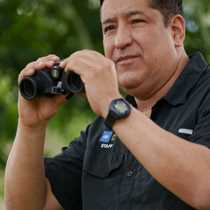Our expedition continued today with an early skiff ride in an oxbow lake known as Atun Poza. Many bird species were seen as black-collared hawks, kingfishers, herons, storks, and many more. We saw the majestic Monk Saki monkeys, and the always agile squirrel monkeys as well. Later on around 0800, we had our breakfast outdoors onboard the skiffs! We had our first meal of the day served in the most fashionable way, white gloves ornamenting our naturalists´ and bartender’s hands, fabric napkins in our laps and even handcraft dolls holding the napkins. As a background, we had the green surroundings of the rainforest, and a concert of tropical sounds as companions.
On our way back to the ship, we paid a short visit to the small village with the same name as the lake, Atun Poza Village. As the water levels in the whole area are slowly but surely going down, many villagers have started to get ready for the upcoming months when they will be an increase in fishing activities. The best part of this outing, for many of our guests, the experience of encountering several canoes of a local fishermen, who showed us the first catch of the day. An incredible variety of fish species were seen, most of them catfish, for these are the most abundant fish in the Amazon. Some estimates suggest that approximately 70% of all fish species in this region are in the catfish families.
Around lunch time, we arrived to the farthest point that we will reach during this week’s expedition—the Pacaya River. At around 1500, we started to travel upstream in our skiffs, and our goal was to go as far as we could into this remote river. The fun was not over yet, for once our skiffs arrived to a large, black-water, oxbow lake called Yanayacu Lake, we were able to go swimming! Many adventurous swimmers went into the water for a refreshing swim in this remote location! Floating noodles, towels, a ladder to come back into the boats, a lot of enthusiasm and a cooler with cold beers and sodas were included!
After our swimming excursion, we continued to explore the area. We spotted a juvenile black caiman, seen floating in a marsh, and some Red Howler monkeys troops were seen as well. These monkeys are one of largest monkey species in South America, and one of the most famous, for they have one of the most impressive voices in the Neotropical rainforests. It was a remarkable afternoon in terms of wildlife sightings.







